Cut & Fill II: Robotic
Remediation Scapes
FALL 2015: ATOMIC CITIES STUDIO VII
The Cut & Fill II Studio carried forward the robotic remediation concepts proposed by Fall 2014’s Cut & Fill I Studio. While Cut & Fill I developed strategies to leverage robotic or numerically controlled earth moving equipment to remediate the PGDP site, Cut & Fill II sought to apply those concepts. Over the course of this semester, students designed fabricated outcomes from parametrically defined earth-moving and shaping definitions. They prototyped the land forms and formal strategies for the PGDP site through scale-simulations using the CNC router and wood-cuts.
Objectives: The Cut & Fill II Studio had several aims. Most importantly, it sought to demonstrate to architecture students that architectural form can and should do something. It aimed to achieve this by challenging the architect’s form-making facility with a compelling and pressing problem to solve that went well beyond traditional architectural challenges. The studio also endeavored to provide students with an awareness of the architect’s capacity for proposing and implementing strategic, or tactical high-performance earth structures. Through engagement with research partners, grant sponsors and project stakeholders, the studio aspired to show that architects might be the right people to lead the design and implementation of robotic remediation strategies at US DOE sites in Paducah and beyond.
Outcomes: Working in teams, students collaborated on a range of project trajectories. One team examined an autonomous future of remediation that could keep humans safe from contamination. Students developed an Arduino-programmed autonomous, sensing ‘robot’, capable of identifying a contaminated canister, then lifting, moving, and stacking it in another location. Other teams tested earth-shaping strategies to facilitate remediation, exploring forms that concentrate, disperse or distribute rainwater, and shapes that direct and control wind flows. Students developed prototyping methods to simulate the construction of large-scale earthforms with numerically controlled, autonomous heavy earth-moving equipment. Translating the scale of Paducah’s site to the scale of the studio, students simulated toolpath strategies with wood-cuts, using the CNC router.
PROJECT TEAM
INSTRUCTOR / Co-PI:
Associate Prof. Gary Rohrbacher
Co-PI:
Associate Prof. Anne Filson
POST-GRAD RESEARCH ASSISTANTS:
Chris Westfall
Eric Shockey
STUDENTS:
(To be Posted)




